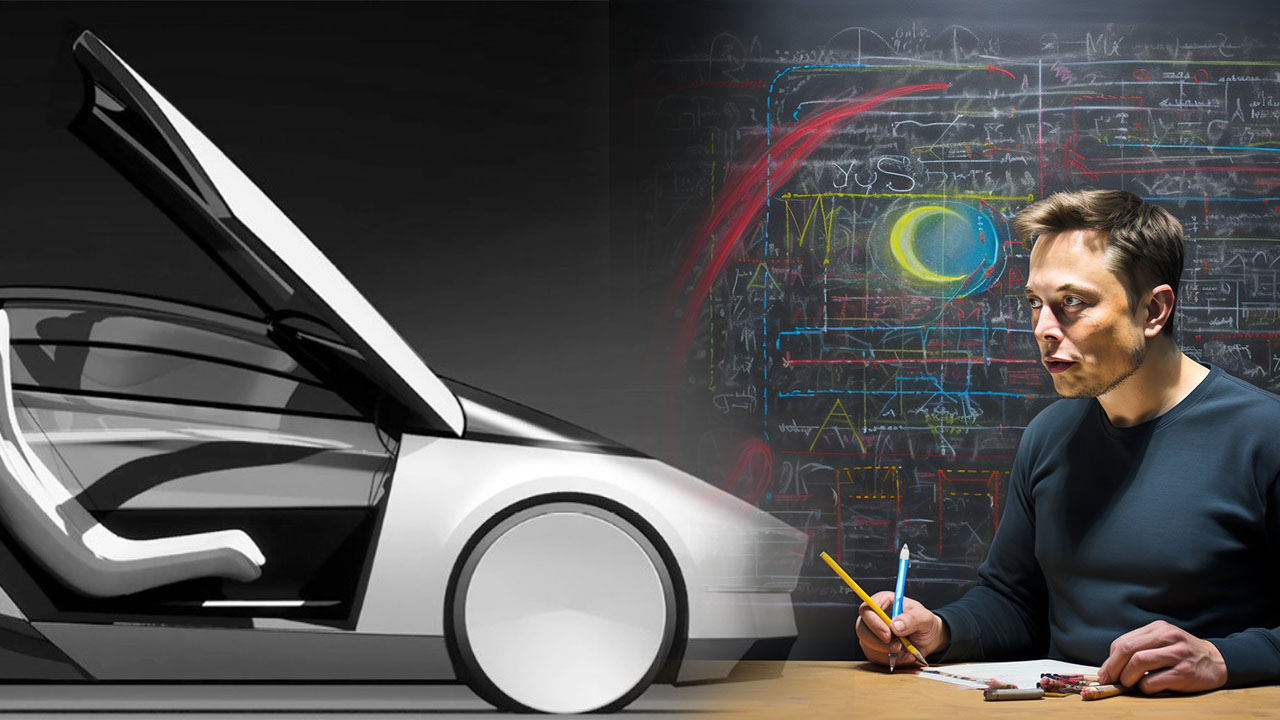Elon Musk's Robotaxi: Hype Versus Reality

Table of Contents
Elon Musk's ambitious vision for a robotaxi fleet has captivated the world, promising a future of on-demand, autonomous transportation. But how much of this vision is grounded in reality, and how much is hype? This article dives deep into the complexities of Elon Musk's robotaxi plans, examining the technological hurdles, regulatory challenges, and the potential impact on the future of transportation. We'll explore the exciting possibilities alongside the significant challenges that stand between us and a world filled with self-driving robotaxis.
The Technological Hurdles of Robotaxi Implementation
The transition to a robotaxi-dominated transportation system faces formidable technological barriers. While significant progress has been made in autonomous driving technology, many critical challenges remain unsolved.
Navigating Complex Driving Scenarios
Autonomous vehicles must navigate incredibly complex and dynamic environments. Unpredictable situations, such as:
- Pedestrian behavior: Unexpected movements, jaywalking, and interactions with children.
- Cyclist interactions: Maintaining safe distances and predicting cyclist maneuvers.
- Inclement weather: Dealing with reduced visibility due to rain, snow, fog, and extreme temperatures.
present significant challenges for even the most advanced AI systems. Specifically, several technical hurdles need to be overcome:
- Object recognition: Accurately identifying and classifying objects in real-time, even in challenging conditions.
- Decision-making algorithms: Developing algorithms capable of making safe and efficient driving decisions in unpredictable situations.
- Sensor fusion: Effectively integrating data from multiple sensors (cameras, lidar, radar) to create a comprehensive understanding of the environment.
Current AI and machine learning algorithms struggle to handle "edge cases"—unusual or unexpected situations—which could lead to accidents.
Ensuring Safety and Reliability
Safety is paramount for robotaxi deployment. To gain public trust, autonomous vehicles must demonstrate an extremely high level of reliability and safety. This requires:
- Robust safety systems: Implementing multiple layers of redundancy to prevent accidents, even in the event of system failures.
- Fail-safe mechanisms: Designing systems that can safely bring the vehicle to a stop if a critical component fails.
- Rigorous testing and validation: Conducting extensive testing under various conditions to identify and address potential vulnerabilities.
Safety concerns remain a major obstacle:
- Software glitches: Unforeseen bugs in the software could lead to unexpected behavior.
- Hacking vulnerabilities: Autonomous vehicles could be vulnerable to hacking attempts that could compromise their safety.
- Sensor malfunctions: Failures in sensors could lead to inaccurate perception of the environment.
Scalability and Infrastructure Requirements
Widespread adoption of robotaxis demands massive investment in infrastructure:
- Charging infrastructure: A robust network of charging stations is needed for electric robotaxis.
- High-bandwidth communication networks: Autonomous vehicles rely on high-bandwidth communication for data transmission and updates.
- Vehicle production, maintenance, and repair: Scaling production, maintenance, and repair operations to support a large fleet of robotaxis is a logistical challenge.
- Software updates: Regular software updates are crucial for improving safety and performance, requiring efficient deployment mechanisms.
Regulatory and Legal Challenges Facing Robotaxis
The legal and regulatory landscape surrounding autonomous vehicles is complex and rapidly evolving.
Navigating Varying Regulations Across Jurisdictions
Obtaining the necessary permits and licenses to operate robotaxis varies significantly across different jurisdictions.
- Liability in accidents: Determining liability in accidents involving autonomous vehicles is a key legal challenge.
- Data privacy: Protecting the privacy of passenger data collected by autonomous vehicles.
- Cybersecurity regulations: Ensuring the cybersecurity of autonomous vehicles to prevent hacking and malicious attacks.
Inconsistencies in regulations across states and countries create significant hurdles for companies aiming for nationwide or global deployments.
Public Perception and Acceptance of Autonomous Vehicles
Public trust and acceptance are essential for the successful integration of robotaxis. Concerns remain:
- Job displacement: The potential displacement of human drivers is a major concern.
- Safety and security: Public perceptions of safety and security are heavily influenced by media portrayals and reported incidents.
Factors influencing public perception include:
- Media portrayal: Negative media coverage of accidents involving autonomous vehicles can erode public trust.
- Accident rates: A low accident rate is crucial for building public confidence.
- Technological advancements: Demonstrating continuous improvements in technology will help build trust.
Elon Musk's Promises Versus Current Progress
Elon Musk has made bold predictions regarding the timeline for robotaxi deployment.
Analyzing Musk's Timeline and Predictions
A comparison of Musk's past statements with current reality reveals a significant gap.
- Feasibility of projected timelines: Many of Musk's projected timelines for robotaxi deployment appear overly optimistic.
- Setbacks and delays: Tesla's autonomous driving program has encountered several setbacks and delays.
Discrepancies between Musk's projections and actual progress highlight the challenges involved in developing fully autonomous vehicles.
Tesla's Full Self-Driving (FSD) Beta Program
Tesla's FSD Beta program provides a glimpse into the current capabilities and limitations of the technology.
- Performance and limitations: The FSD Beta program has shown promising results but also reveals limitations in handling complex driving scenarios.
- User feedback and reported incidents: User feedback and reported incidents provide valuable insights into the strengths and weaknesses of the system.
- Ongoing development and improvement: Tesla continues to develop and improve the FSD system, but significant challenges remain.
Conclusion:
Elon Musk's vision of a robotaxi future presents a compelling yet complex prospect. While the technological advancements in autonomous driving are remarkable, significant hurdles remain in terms of safety, regulation, and scalability. The gap between the hype surrounding Elon Musk's robotaxi promises and the current technological reality is substantial. Continued innovation and rigorous testing are crucial before widespread robotaxi adoption becomes a tangible reality. To stay informed on the latest developments in this rapidly evolving field, continue following news and analysis on the progress of Elon Musk's robotaxi plans and the broader autonomous vehicle industry. Keep researching and learning more about the future of robotaxis and their impact on transportation.

Featured Posts
-
 Dope Thief Episode 7 Review A Return To Form
Apr 25, 2025
Dope Thief Episode 7 Review A Return To Form
Apr 25, 2025 -
 Legal Representation Following A Car Accident Protecting Your Rights
Apr 25, 2025
Legal Representation Following A Car Accident Protecting Your Rights
Apr 25, 2025 -
 Understanding Cool Sculpting Risks Lessons From Linda Evangelistas Case
Apr 25, 2025
Understanding Cool Sculpting Risks Lessons From Linda Evangelistas Case
Apr 25, 2025 -
 Cassidy Hutchinson Key Witness To January 6th Announces Memoir
Apr 25, 2025
Cassidy Hutchinson Key Witness To January 6th Announces Memoir
Apr 25, 2025 -
 Ftv Live Meteorologist Faces Sexual Extortion Allegations
Apr 25, 2025
Ftv Live Meteorologist Faces Sexual Extortion Allegations
Apr 25, 2025
Latest Posts
-
 Investigating Michael Sheens Million Pound Gift
May 01, 2025
Investigating Michael Sheens Million Pound Gift
May 01, 2025 -
 Michael Sheens Generous 1 Million Impact And Transparency
May 01, 2025
Michael Sheens Generous 1 Million Impact And Transparency
May 01, 2025 -
 The Deadliest Food Doctor Says Its Worse Than Smoking And A Major Cause Of Early Death
May 01, 2025
The Deadliest Food Doctor Says Its Worse Than Smoking And A Major Cause Of Early Death
May 01, 2025 -
 Understanding Michael Sheens Recent 1 Million Philanthropic Act
May 01, 2025
Understanding Michael Sheens Recent 1 Million Philanthropic Act
May 01, 2025 -
 The Truth About Michael Sheens Million Pound Charity Initiative
May 01, 2025
The Truth About Michael Sheens Million Pound Charity Initiative
May 01, 2025
